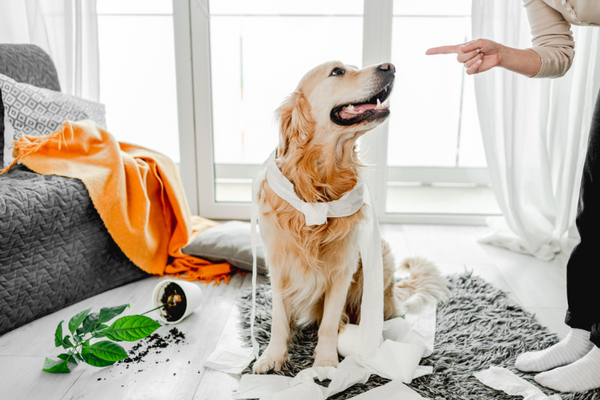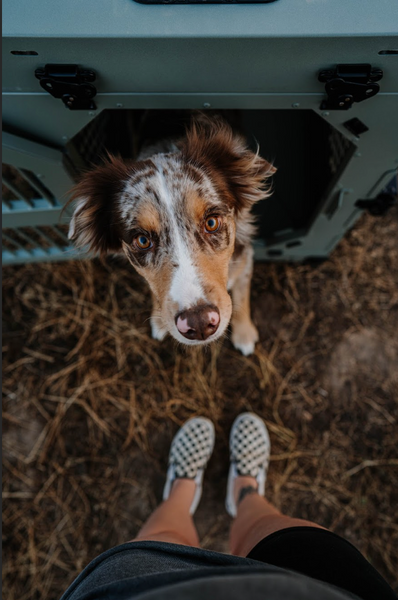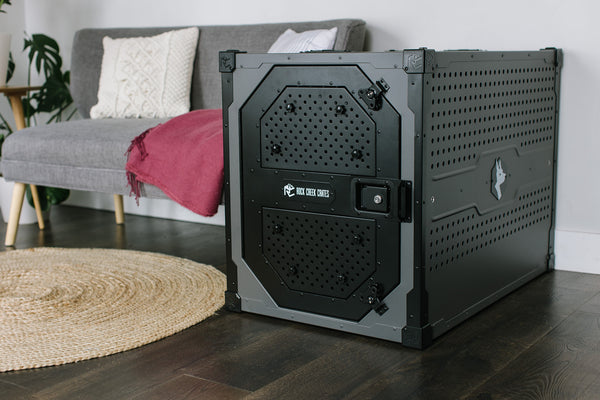Your dog’s crate isn’t just a safe and easy space for them, it brings pet parents peace of mind, too. Destructive behavior is anything but uncommon in dogs, and even the most well-behaved pet may fall victim to temptation when they’re left without supervision. If you’re wondering “Should I crate my dog when I leave the house?” the answer may vary from person to person, but crating while home alone is always the safest option.
Why Do Dogs Engage In Destructive Behaviors?

Destructive behaviors are one of the top reasons why pet parents choose to crate their dogs when they leave the house. Even dogs who otherwise behave beautifully may find themselves “getting into things” they shouldn’t when left alone. According to the Animal Humane Society, some of the most common reasons dogs engage in destructive behaviors include:
• Separation anxiety – Separation anxiety is one of the single most common reasons dogs engage in destructive behaviors when left alone. Dogs with separation anxiety develop strong co-dependent relationships with their owners, which cause them great stress when they can’t be by their side. Often, dogs will try to calm or release this stress by shredding, biting, chewing, eating, or otherwise destroying the property around them. This can lead to dogs ingesting undigestible or dangerous items or harming themselves by scratching or shredding the environment around them.
Separation anxiety can develop at any time and in any dog. For owners of rescue dogs, it may be an inherited issue which developed from uncertain circumstances long before they found their new pet parents. A change in schedule, a move, a change in the family dynamic, a traumatizing event, or too little time spent apart can all lead to the development of separation anxiety.
• Fear triggers – Fireworks, thunderstorms, construction sounds nearby, or sirens are all common fear triggers for many dogs. When home alone, if a dog is faced with one of their fear triggers, they’ll look for an outlet that makes them feel grounded or “safe”. Humans aren’t much different; when a human is faced with a phobia, they will feel feelings of panic, anxiety, and extreme stress. However, as humans, we know how to recognize and handle these feelings in healthy ways – our dogs do not. Instead, they may chew on items in their environment, they may try clawing at walls or windows in an effort to “escape”, and they may put themselves in harm’s way without realizing they’re making the situation worse.
Even dogs who typically do very well at home alone may engage in destructive behaviors when exposed to one of their fear triggers. There is no way to predict a couple of booms of thunder or a neighbor shooting off a firework, but a crate is a solution that can always be relied upon.
• Boredom – When you’re left home alone for a long period of time, you’re likely to get bored eventually. Your dog is no different. While you may not think “eat the sofa cushions” sounds like a fun game, your dog may beg to differ. Even a house full of toys can get tired if your dog has no one to play with, and this leads to tempting destructive “games” instead.
• Curiosity – Dogs are naturally curious creatures, and this is evident during any walk you take, new toy you bring home, or game you invent. Sometimes their natural curiosity may lead them into trouble and their investigation of their surroundings may lead to destructive tendencies.
How Dangerous Are Destructive Behaviors?
Destructive behaviors aren’t just dangerous to your property – they’re extremely dangerous to your dog. While dogs may injure themselves by scratching or clawing, by far the most dangerous consequences of destructive behaviors are bowel obstruction and poisoning.
Bowel obstruction occurs when your dog ingests material that is not digestible. Foam, stuffing, socks, toys, and other items commonly found around the house might be enticing to your dog when left alone, and they can all cause serious issues in a fairly quick span. While some dogs may pass small items, or be able to “regurgitate” them, it’s not a gamble any pet owner should be willing to take.
According to Vet Met Consultants, signs of bowel obstruction that pet parents should look out for include:
• Vomiting
• Loss of appetite
• Abdominal pain or swelling
• Frequent gagging
• Drooling
• Constipation
• Dehydration
• Anxious or lethargic behavior
• Dehydration
When an obstruction is suspected, pet parents should take their dog to the veterinarian straight away. The price of surgery to remove an obstruction can vary widely, but according to Canine Journal the cost may range from around $800 all the way to $7,000. To diagnose an obstruction in a dog a veterinarian will first do a physical exam, follow with X-rays, in some instances perform an ultrasound, and carry out bloodwork before carrying out obstruction removal surgery.
The average home contains various toxic or poisonous items that many pet parents don’t even consider on a day-to-day basis. Cleaners, a bar of dark chocolate, or pesticides tucked away and forgotten can all seem very tempting to a dog left alone. Next to obstruction, accidental poisoning is another very common hazard pets may face when left home alone and outside of their crate.

Why A Crate?
Crates provide a safe, relaxing, and controlled environment that’s safe for your dog and peaceful for you. When seeking out a crate, it should be appropriately sized, destruction-proof, and comfortable to ensure complete peace of mind for you and coziness for your furry best friend. For dogs with separation anxiety, a separation anxiety focused crate can provide additional benefit for your dog’s comfort and relaxation.
Many pet parents may believe that their dog is happier outside of their crate, but too often this is the result of well-meaning owners thinking like humans instead of thinking like dogs. According to the AKC, or the American Kennel Club, dogs are natural den animals, and they still exhibit many denning behaviors despite living in domestic homes. When your dog makes a little pocket for themselves under the covers, or when they rustle up blankets on the sofa to create their own cozy nest, these are signs your dog is expressing their natural denning instincts.
Providing your dog with a crate is providing your dog with a den. The crate gives your dog what their instincts crave, and this can solve many of the destructive behavior issues you may face any time you leave the house. For dogs with separation anxiety, it’s a natural calming space they can retreat to for comfort and feelings of safety even while you’re away. Not only can it save them from carrying out destructive behaviors, but it can also naturally help to ease stress and get them used to confidently spending necessary time apart.
Dogs who may be faced with a fear trigger while in the crate may be able to learn to better cope with these triggers if they have the safety of their own secure space. They’ll be in their natural den environment, where they’d retreat to if they were in the wild and faced with a fear trigger, giving them safe exposure in a space that won’t allow them to pose themselves any harm.
It’s Never Too Late For A Crate
Even if your adult dog has never been crate trained before, it’s never too late to introduce a crate into their lives for comfort and safety – whether you’re with them at home or not. To introduce a dog or puppy to a new crate, first begin with positive exposures while you’re present and with the door open. Allow them to eat their dinner in their crate, give them special treats in their crate, or save special toys for crate time only. As they begin to build this positive association, they’ll grow more comfortable with the crate and even begin to look forward to their open-door crate time.

Once your dog is comfortable and excited about their crate time, you can begin trying to close the crate door for short periods. Begin with just a few seconds first, and work your way up to a few minutes, to ten or fifteen minutes, to a half hour. After your dog has their closed-door time, reward them with plenty of praise, treats, and positivity. Once they’re comfortable with this closed-door time, try leaving the room for a little while as they spend time in their crate alone.
With patience and positivity, crate training is a natural process that any dog can learn to enjoy.
Investing In The Right Crate
When asking yourself “Should I crate my dog when I leave the house?” the answer is yes – but only if that crate is destruction-tested. Dogs with anxiety, bored dogs, or dogs with fear triggers may successfully break free from less sturdy crates, putting you in the same position you’d be in if you never invested in a crate at all. In some instances, dogs may even injure themselves during their “break out”, and before they have the opportunity to have free roam of the house.
When investing in a safe crate that your dog can use as their den space while you’re away, research and investigate the crate you’re investing in. An internally welded aluminum frame can stand up to even the strongest and most determined dogs of any breed, and additional safety features like reinforced latches ensure the smartest dogs can’t figure out how to open up the crate by themselves. It’s only this kind of crate that provides the right peace of mind for pet parents and the most complete safety for their dogs.

